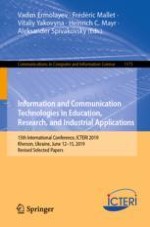2020 | OriginalPaper | Chapter
The Use of Analogy to Simplify the Mathematical Description of the Didactical Process
Author : Paweł Plaskura
Published in: Information and Communication Technologies in Education, Research, and Industrial Applications
Publisher: Springer International Publishing
Activate our intelligent search to find suitable subject content or patents.
Select sections of text to find matching patents with Artificial Intelligence. powered by
Select sections of text to find additional relevant content using AI-assisted search. powered by



 (Materials of the International Scientific and Practical Conference: Methodology of Teaching Natural Sciences in Secondary and High School (XXIII Karischinskiy Reading)), pp. 337–340, Poltava V.G. Korolenko National Pedagogical University, Poltava, May 2016
(Materials of the International Scientific and Practical Conference: Methodology of Teaching Natural Sciences in Secondary and High School (XXIII Karischinskiy Reading)), pp. 337–340, Poltava V.G. Korolenko National Pedagogical University, Poltava, May 2016
 (Pedag. Sci. Theory Hist. Innov. Technol.)
(Pedag. Sci. Theory Hist. Innov. Technol.) 
 (Pedag. Sci. Theory Hist. Innov. Technol.) (17), 152–159 (2018).
(Pedag. Sci. Theory Hist. Innov. Technol.) (17), 152–159 (2018).